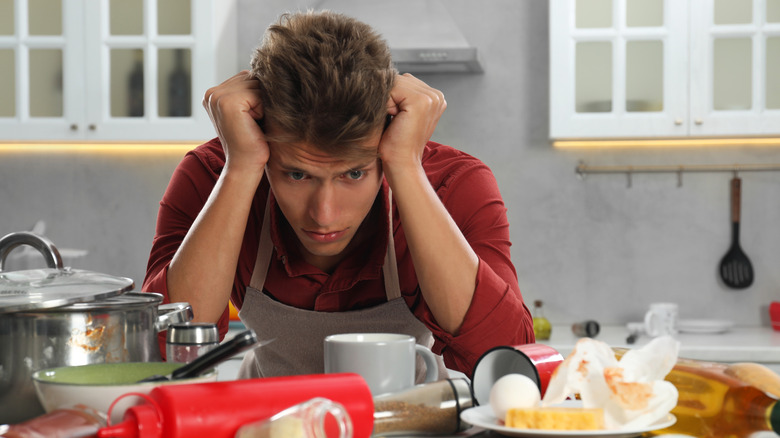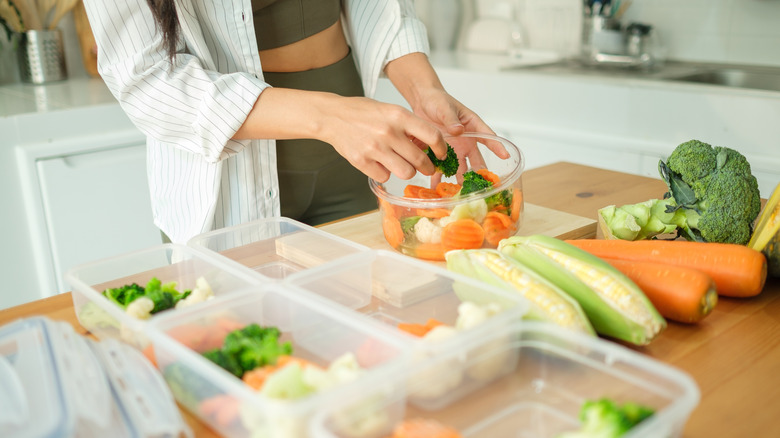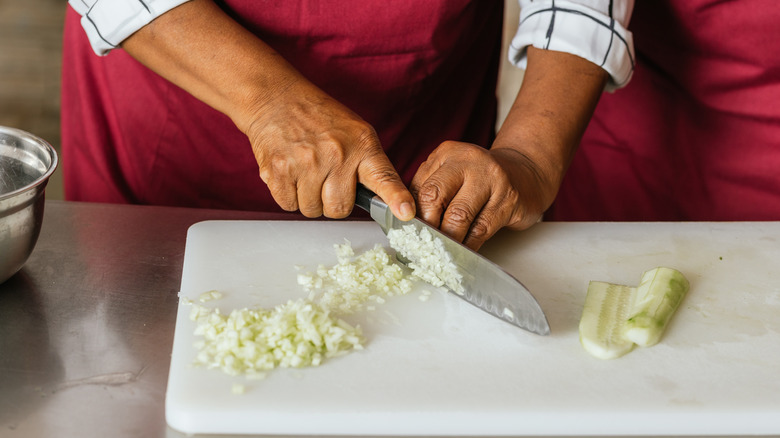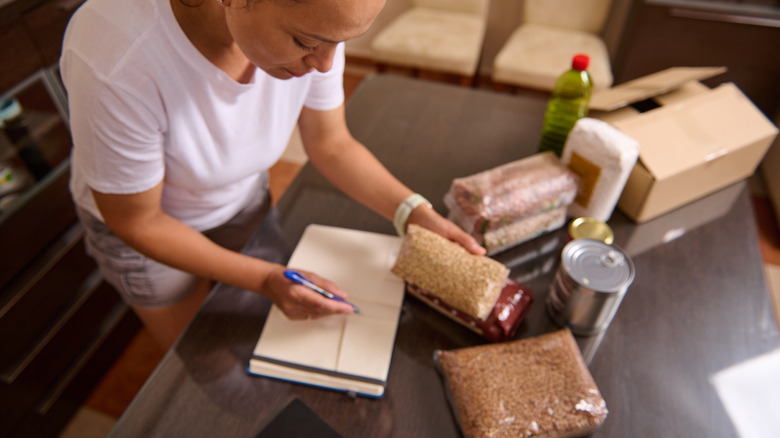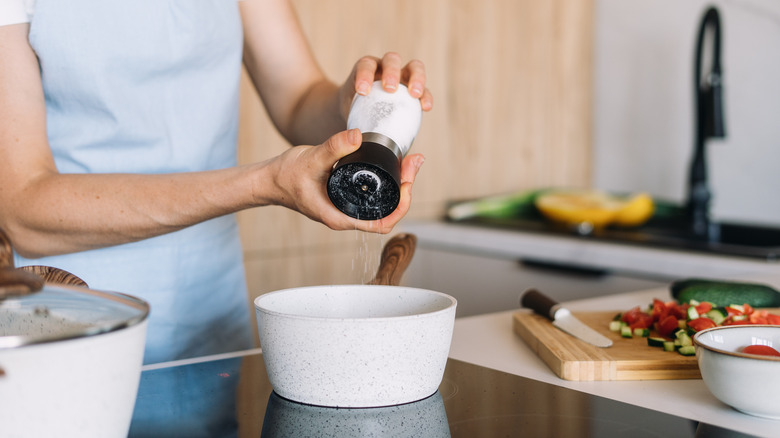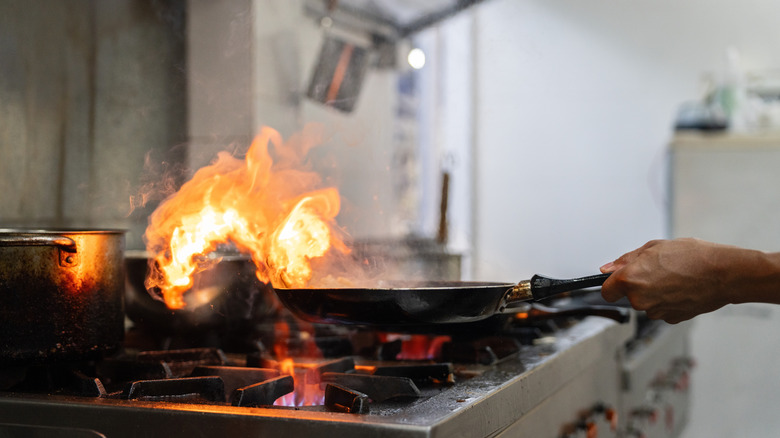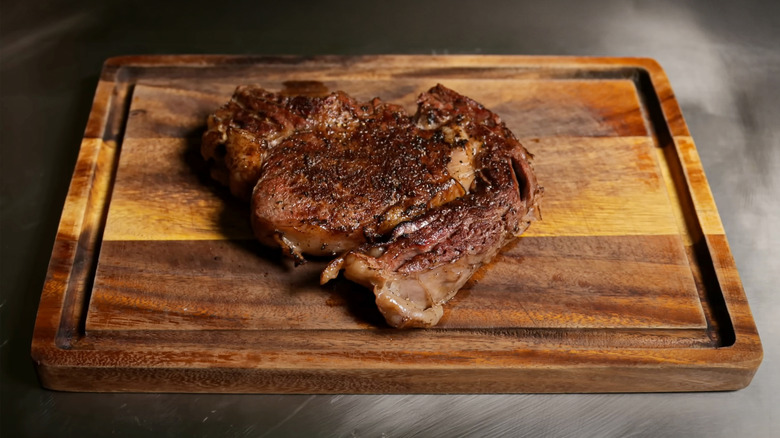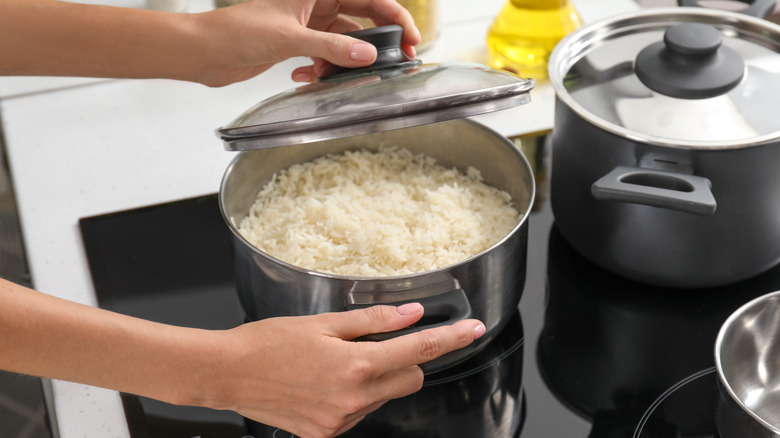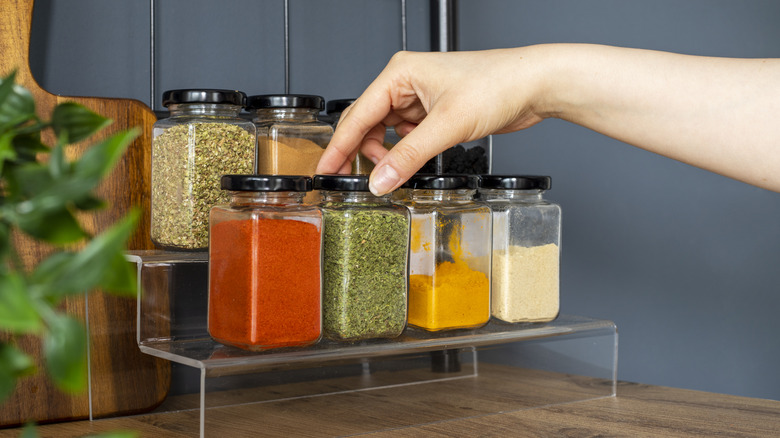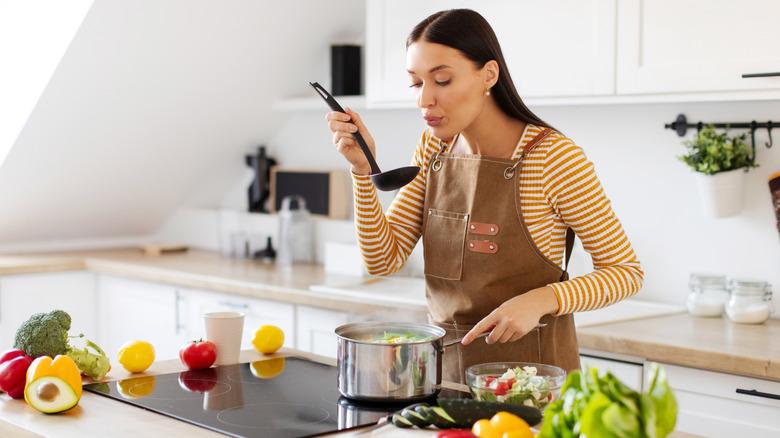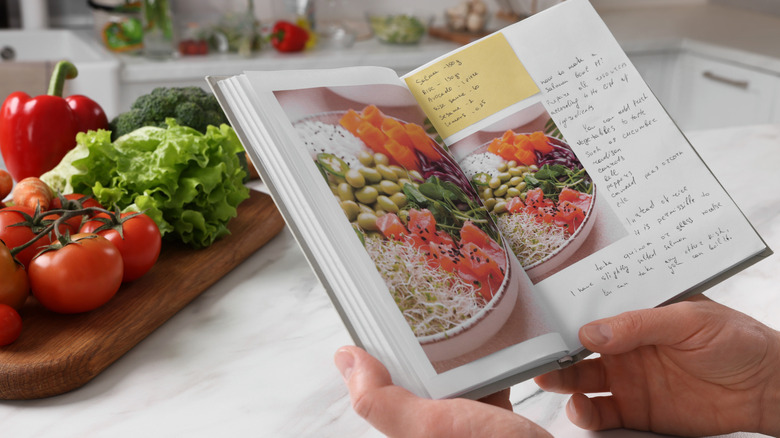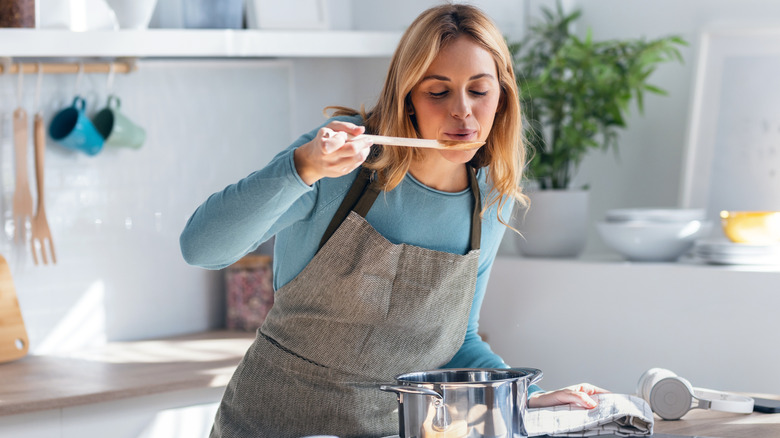11 Common Mistakes New Cooks Make In The Kitchen — And How To Avoid Them
No one is born a great cook. We promise you — it's a skill built over time and through a fair bit of trial and error. For every beginner who has stepped into the kitchen and felt intimidated or confused about where to begin, we know the feeling. We also know how small mistakes can quickly derail a meticulously planned meal, but the good news is that these glitches are entirely avoidable.
Every misstep is also a lesson — and we turned to two seasoned chefs who know what it takes to build confidence in the kitchen. Chef Simone Byron, founder and president of The Navigate Program, works with high school students and young adults to equip them with real-world culinary and hospitality experience through mentorships and national events like the Shef Festival and the U.S. Culinary Open.
We also spoke with the award-winning Chef Morrisa Engles, an instructor at the Auguste Escoffier School of Culinary Arts, whose approach blends plant-based cooking with holistic wellness. Through Engles' businesses, Melanated Flow and FlvrFlow, she teaches everything from cooking classes to yoga, promoting a mindful and balanced relationship with food. Together, these chefs share their insider perspective on the most common mistakes new cooks make and how to fix them before they happen.
Clean, Prep, and Plan Before You Cook
The unanimous advice from both our experts was simple but essential: be prepared. And by this, they mean not only mentally, but also to organize your kitchen and ingredients in advance. The technical term, "mise en place," which loosely translates to everything in its place, is a professional skill that can easily be replicated at home. A professional kitchen would not survive without this practice of prepping and arranging all ingredients, tools, and equipment before cooking begins. It's a system designed to save time and prevent mistakes, keeping everyone around focused on the tasks at hand.
According to Chef Morrisa Engles, "Mise en place gets you organized, confirms that you have what you need, and speeds up the cooking process by allowing you to easily flow from one step to the next." She adds that most beginners miss out on these important steps before even starting to cook. For her, a clean and organized workstation is important not only for hygiene purposes but also to ensure a better flow in the kitchen.
Chef Simone Byron agrees wholeheartedly and urges all home cooks and newbies to take the time out to prepare and organize. "Skipping mise en place — having ingredients measured, tools ready, and a plan in mind –– sets them up for stress and errors. Cooking becomes so much smoother when you slow down at the start."
The Knife Techniques That Change Everything
As a new cook, there's one skillset that can instantly elevate your meals, and that, according to our experts, is mastering knife techniques. It may sound too professional and a bit daunting, but once you learn how to choose the best knives and handle them correctly, your prep time will become easier, safer, and yes, your food will taste better too. "I think you also need to find what type of knife you're comfortable with," says Chef Simone Byron. "The handles are different, some blades are heavier –– you have to find [what's right for] your hand."
Our experts also remind us not to underestimate the power of the proper knife grip. "Many new cooks notice hand and wrist fatigue, especially when chopping," says Chef Morrisa Engles. "It's the grip! The palm and last three fingers should be wrapped around the tang or handle of the knife, while the forefinger and thumb should be pinching the end of the blade near the bolster. This grip allows for healthier wrist movement and more control."
Byron adds that many newbies in the kitchen lose control over the knife by holding it too far back and potentially put their fingers at risk by not curling their non-knife-holding hand into the "claw." This grip helps avoid any mishaps by curling your fingers and stabilizing whatever you're chopping with your fingernails rather than the pads of your fingers.
Know Your Tools, Know Your Kitchen
A well-stocked and organized kitchen is one way for new cooks to conquer their fears and master the skills they need to succeed. From small habits that can extend the life of your ingredients to having the right utensils and appliances, the way you handle and manage all facets of your kitchen makes a huge difference. For Chef Simone Byron, waste in professional kitchens is a strict no-no, and she cautions you to never leave perishables out too long. Even something as simple as avoiding overcrowding your fridge ensures a good airflow and keeps produce fresh for longer.
Chef Morrisa Engles urges you to start thinking like a professional. According to her, many new cooks overlook simple systems that can save time and keep food safe. "While this may seem like it's just for restaurants, it's for your home too," Engles shares. "FIFO, or First in, First Out is an important inventory system where the oldest products are used first and requires new items to be stored behind older ones. Utilizing this inventory system will prevent food waste and save you money." Knowing your kitchen means knowing both your tools and your ingredients and having a system that makes your cooking smoother and more efficient. Small habits can extend the life and flavor of your ingredients. For instance, learning how to store herbs to keep them fresh will make them last longer, giving you better results and less waste.
Season Like a Chef
Seasoning is so much more than adding salt, pepper, and a careless dash of red pepper flakes. There's skill and technique involved in layering flavors and building depth from the very first step of cooking. Our chefs recommend that all beginners learn to embrace the art of seasoning and start layering their chosen flavors early on in the cooking process. Chef Morrisa Engles explains that, "This can be done in a few ways, including seasoning each addition to a dish. For example, a pot of chili gets a little salt and pepper on the veggies, the protein is seasoned, any liquid is flavored, and then you taste and adjust at the end."
For Chef Simone Byron, the other big issue with seasoning is that many err on the side of caution and end up with flavorless dishes. "People are afraid of salt, but it's essential for flavor," she says. "The rule to remember is 'You can always add more, but you can't take it out.' In other words, get in the habit of layering seasoning gradually." And let's not forget the importance of balancing out the flavors. Salt and sweet can be equalized with a dash of lemon juice or vinegar. Adding a last-minute splash of acidity to any dish can go as far as salt can toward brightening the final product.
Learn to Read the Heat
Heat can make or break your meal. And not only by burning or undercooking things. As a novice, understanding how heat works on various ingredients can help you fine-tune the results of your dish. For example, when baking, it's almost impossible to create an edible and delicious cake without monitoring the heat of your oven. In much the same way, meat and proteins should be checked regularly to ensure that they are being cooked properly and served safely. Knowing the right internal temperature for your fish, beef, or chicken, or recognizing what the perfect finish looks like, can help you confidently pull off even more complicated dishes.
"A thick, tough cut of meat might need to be roasted low and slow, while a delicate fish filet might be broiled for a short time," Chef Morrisa Engles says. "New cooks should be attentive and observant during the cooking process and make adjustments. Admittedly, this can take some practice, but it's something all cooks can develop over time."
Chef Simone Byron adds that one of the most common mistakes beginners make is cooking at extremes. They often cook at too high a heat and burn the outside of their meal while the inside still needs time. Conversely, cooking at too low a heat, usually out of fear, can leave food soggy or greasy. "The key is knowing when to use high heat for searing versus gentle heat for simmering," Byron clarifies. "That really starts with knowing your equipment — every stove cooks differently."
Know the Protein Rules
There are innumerable rules a newbie in the kitchen needs to follow when it comes to handling, cooking, and serving protein. But don't be put off by handling beef, chicken, pork, or even seafood. While it is true that these ingredients can be mishandled at home –– especially when it comes to proper sanitation and handling of raw meats –– a few smart habits can make all the difference.
Chef Morrisa Engles details a few of these essential practices: "Some examples include using a separate cutting board for meats and vegetables, cleaning and sanitizing your workstation after handling raw meats, and storing them at the proper temperature at the bottom of the refrigerator." When cooking meat, investing in and using a meat thermometer correctly is invaluable. Checking the internal temperature before serving can go a long way toward preventing foodborne illnesses.
For Chef Simone Byron, how proteins are cooked is just as important as how they're handled. "Overcrowding the pan is a big one –– it steams the food instead of searing it. Not drying proteins before cooking is another." Because excess surface moisture prevents caramelization, patting meat dry before it hits the pan helps it brown properly instead of turning gray and soggy. Learning how to rest steaks and other meats properly is another important consideration. As a general rule, let smaller cuts rest for 5 to 10 minutes, and larger roasts for 15 to 20 minutes. Cutting it too soon causes all those flavorful juices to spill out onto the plate instead of staying inside.
Master Those Pantry Staples
While recipe books are full of elaborate dishes with long ingredient lists, what about mastering the basics? Any good cook knows the value of a perfectly cooked staple. Whether it's a steaming bowl of fluffy rice, al dente pasta, or perfectly buttered mashed potatoes, the importance of getting staples right is as important as cooking the main dish properly. Chef Morrisa Engles suggests, "It's good to carefully follow the directions on the package and drain any excess liquid immediately. For rice and grains, allow them to sit covered and untouched for 5 to 10 minutes before fluffing. This gives any residual liquid time to fully absorb, providing a better texture."
Chef Simone Byron understands how easy it is for beginners (and often professionals) to overcook pasta or forget to salt the water, which is the only moment to season these staples from within. She adds, "With rice or grains, lifting the lid too often interrupts the cooking process and ruins the texture." While you could give this rice flipping trick a try, other ways to ensure perfectly cooked rice and pasta include using the right ratio of water to grain, resisting the urge to stir too often, and tasting for doneness rather than relying solely on time. When it comes to pasta, always save a splash of starchy cooking water as it's liquid gold for helping sauces cling beautifully.
When to Add Herbs, Spices, and Aromatics
As Chef Simone Byron sums it up, "The biggest issue is that most don't know the true flavor profiles of each herb, spices, etc. You really can't use them effectively if you don't know their power." She adds that many new cooks burn garlic by adding it too early, or waste the flavor potential of dried herbs by incorporating them too late. "Fresh herbs are either chopped way in advance, so they turn brown, or added too early and lose their brightness."
Chef Morrisa Engles agrees that beginners are often unsure how to cook with spices and aromatics, noting that the most common mistake is not knowing when to add these items. The basic rule to remember is to add dried components early and fresh ingredients late. "Hardy herbs like rosemary and sage can be added at the beginning of the cooking process, but soft herbs like cilantro and parsley should be added at the end to preserve color and flavor."
To get the most out of your seasonings, you should bloom spices for stews or at the beginning of any cooking process. This simple step unlocks fat-soluble flavor compounds and gives dishes a richer, more layered profile. Engles continues, "Garlic, ginger, scallions, and other aromatics should be gently awakened at the beginning of the cooking process to draw out their deep, earthy tones and fragrance without the bitterness."
Taste Early, Taste Often
"Yes, new cooks often forget to taste while cooking," Chef Morrisa Engles shares, reminding us not to become complacent. Even when you've made a dish plenty of times, don't assume you won't need to tweak anything. "I like to say, 'taste the water,'" Engles continues. "I laugh when I say it, but I'm not joking. Every ingredient added to a dish changes it, whether it's the flavor, texture, or consistency." Seasoned chefs understand that ingredients vary: the jalapeños could be spicier, the lemons sweeter, or the chocolate could have a different texture. The only way to catch those shifts is to taste often and adjust along the way.
If you practice tasting as you cook, you'll train your palate to recognize what's missing in a dish. Maybe it needs a bit of salt to liven it up or another squeeze of lemon juice to cut through the richness. It's often a matter of knowing when to take it off the heat or when to let it simmer for just a bit longer to develop more flavor. The more you taste, the more instinctive these adjustments become. Chef Simone Byron notes that taste testing ties back to layering flavors, saying, "Cooking is interactive, not rigid. If you don't taste and adjust, you miss the chance to balance flavors and textures. That's why some dishes come out flat — it's like skipping the most important step."
Read the Recipe Twice (Then Make It Yours)
Recipes can spark both excitement and terror in a new cook. While long lists of ingredients and complicated techniques can steer you into common recipe reading mistakes, our experts say the real trouble often lies elsewhere. Chef Simone Byron shares, "I see two extremes: some cling too tightly to every word and panic when they don't have the exact ingredient, while others go off-script before they understand the basics. Recipes are both a map and a lesson — follow them first, then improvise."
There are simple ways to maximize the efficacy of a recipe. For Chef Morrisa Engles, this involves reading every recipe carefully. Recipes are often developed after multiple trials and created to ensure the best results, so put your faith in the process. "I like to encourage reading the recipe in its entirety first, then reading each step again as you move through the cooking process," Engles says. "This way, you know what to expect and you get helpful reminders as you go. It's a great idea to follow a recipe closely the first time you make it, then take notes and make any adjustments next time!" And once you've followed a recipe to the T a couple of times, that's when your creativity can be unleashed. By then, you will know which parts can be swapped and which instructions should not be played around with.
Cook with Confidence, Not Perfectionism
As new cooks, this list may seem overwhelming, but our experts leave us with one final bit of advice. They understand that, as a beginner, you may be held back by the fear of messing up. But here's the truth: every great cook has burned, oversalted, or undercooked something on their way to mastery.
There's one thing you need to understand. "Chefs are scientists. We love to experiment with the flavors and properties of food," Chef Morrisaa Engles shares. "That said, some experiments don't produce the results we're after. Don't fear this! It's part of the learning process and is what will eventually make each dish stellar." She adds that consistent trial and error with flavor, texture, and presentation will lead to dishes that are uniquely yours.
This unique aspect is perhaps the most important takeaway. Everyone can cook, but when you put your heart and soul into a dish, the results speak for themselves. Fear of failure will only keep you from improving. Chef Simone Byron puts it simply: "People think a mistake means they're not good at cooking, when in reality mistakes are the best teachers. Perfectionism is another trap — waiting for the 'right' tools or the perfect conditions. Cooking is about confidence, and confidence only."
